© Steven J. Cary, October 2022
We have four adventures for your reading pleasure. But first, please note that Jenna Stanek has done a terrific story on the conservation and regulatory status of Monarch Butterflies; check that out here: Nature-Notes-No.4-Final.pdf (peecnature.org).
Also, if you have submitted New Mexico butterfly photos/records to BAMONA but have not heard back about one or more submittals, please let me know via email; be sure to include the record numbers. A few submittals have gone missing of late, but I can help track them down and get them processed. Thank you!
And now the stories in this current post . . .
Butterflying While Peak-bagging, by Marta Reece. Driving is a problem for me and my car is not reliable. So to get far and see new butterflies, I partnered up with a peak bagger. Joe drives and gets to make our travel plans. On Sunday, September 18, we got up at 3:30am and did Holt Mountain over in Catron County and an unnamed peak to the southwest of it. We hiked 11 miles and climbed 4200 vertical feet, a significant portion of it off-trail on steep terrain littered with deadfall.
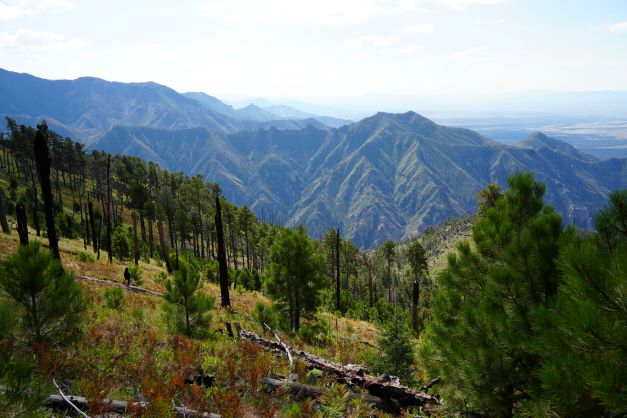
As is often the case on our trips, the walk in was too early for butterflies. We were at 8000 feet before I saw a few Red-Bordered Satyrs flitting about through the forest of tall pines. The trees separated well enough to let in light and allow undergrowth, but nothing was blooming. The first butterfly I was able to photograph was a solitary Tiny Checkerspot. By that time, we were practically at the summit of Holt Mountain. I was hoping that 9780 feet was too high for that species, which is routine in and near my Las Cruces home base, and that I had some other, more intriguing, checkerspot. Surely there were some checkerspots I had never encountered before. I tend to hope. And get disappointed. It may not be rational, but it does make hunting butterflies a lot more fun.
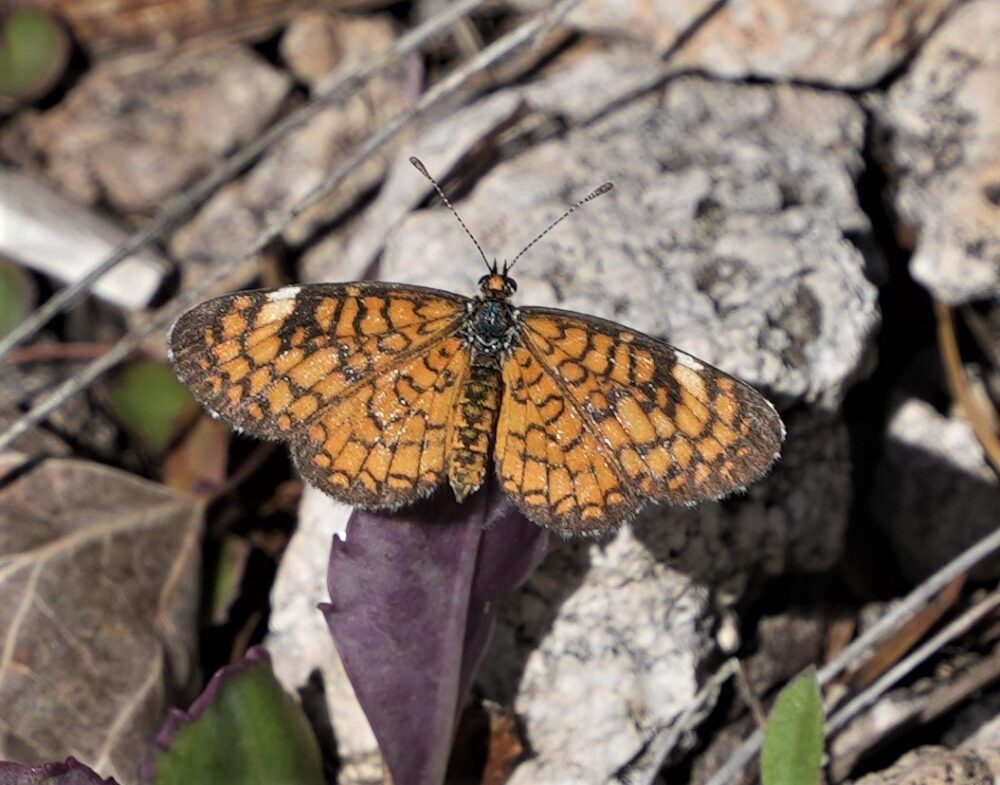
Going down, we were on a south-facing slope covered in a sparse forest with some rock outcroppings. Red-bordered Satyrs were getting to be a regular presence but I paid little attention to them as I had to watch my footing and try to keep up with Joe. As we made our way toward the long ridge connecting the two mountains, I came across one Red-Bordered Satyr trapped under some branches. It opened its wings on and off, and I tried hard to get a dorsal shot. I didn’t get much. At this point, our day was halfway over and my haul was disappointing.

All that changed quite suddenly once we reached the narrow ridge connecting the two mountains. As we stepped out of a clump of bushes, before us was a meadow of white, fluffy flowers. I have seen those flowers before but didn’t know their name. The area wasn’t more than thirty feet across and half of that was bare ground, but the flowers fluttered with visitors. There were Painted Ladies and American Ladies, a Monarch and a Black Swallowtail, a flock of Snouts, some Sulphurs, but most important of all was a single Hoary Comma. This was a new species for me. I was two species shy of my goal for the year, and here was one of them, posing for me pretty as you please, too busy to notice me taking picture after picture.
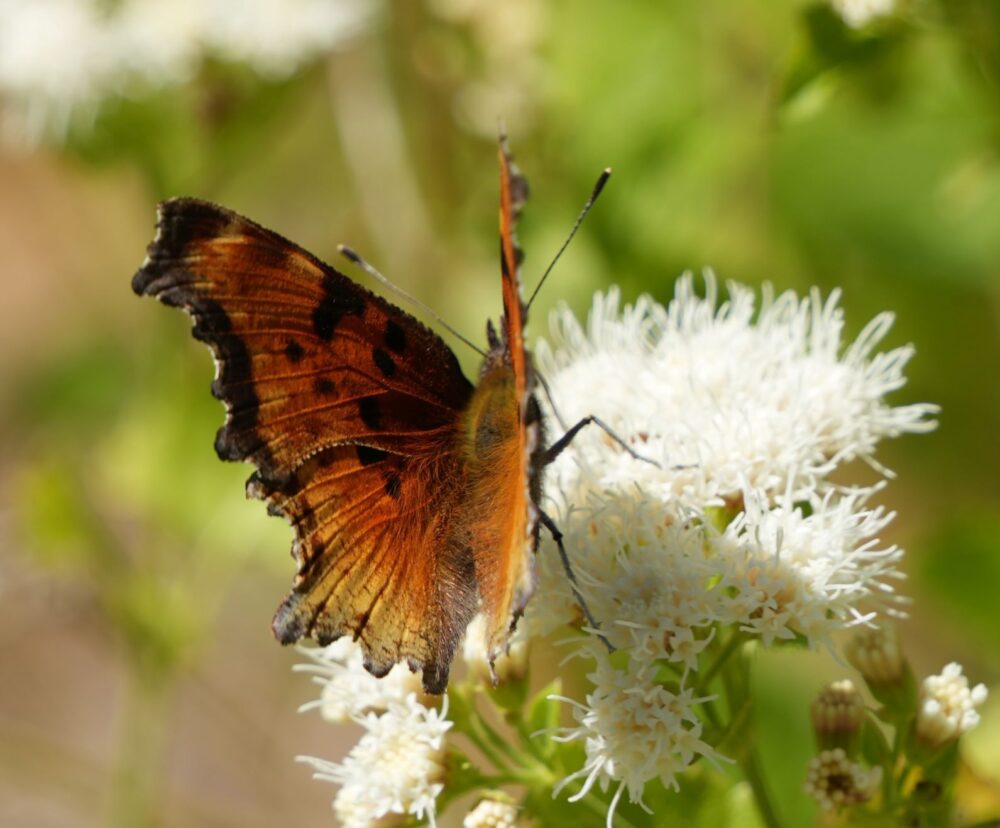
My partner was patient with the delay. We were ahead of schedule and the big uphill push was behind us. Finally, I straightened up and looked around. I could see more clusters of the same white flowers along the ridgeline ahead of us and started toward them in eager anticipation. I don’t know why, but these flowers did not attract the same attention, even though they were the same species and looked just as healthy and happy.
Continuing along the ridge, the land rose only slightly overall, but steep-sided protrusions of rock made the place picturesque. We were at the base of one such formation, close to where the land started rising toward the next peak, when my partner pointed out “a little butterfly” on a rock ahead.
“There is a rock above that rock,” he said, “but it’s on the low rock.”
There were about twenty rocks to choose from, but somehow I knew immediately which one he meant even though he didn’t point, not wanting to scare it. The “little butterfly” was a medium-sized fold-wing skipper. I snapped a couple of shots from a distance, just to have something, and tried to get closer for a better shot. The moment I moved, the skipper flew up. I froze and waited for it to come back the way perched skippers tend to do. It did. To the same spot. Then it skipped to a different spot a foot to the side. Then to a flower right behind the rock. Then to the same spot again. Once I had enough shots, I took a look at it with my binoculars. Sure enough, it wasn’t anything I’d ever seen before. When I identified it at the end of the day, it turned out to be an Apache Skipper. At over 9000 feet, it was a bit high for this species. And patrolling a tiny patch of ground at the base of an outcrop didn’t really qualify as hill-topping. But Apache Skipper it was, and my goal for the year was reached.
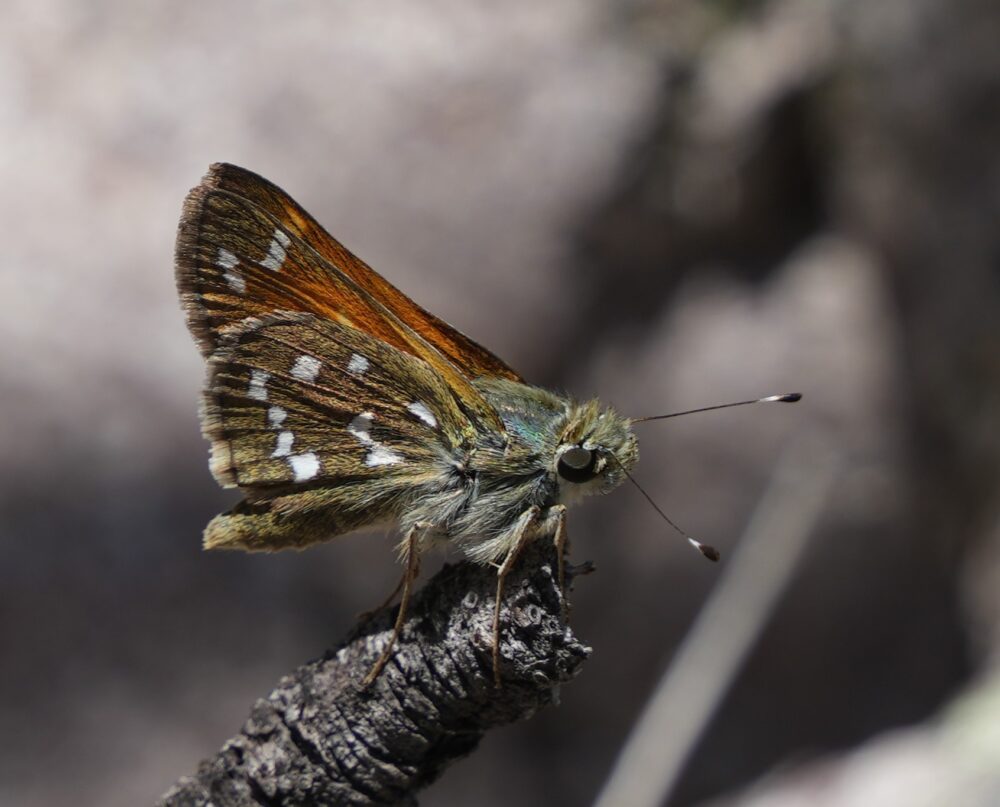
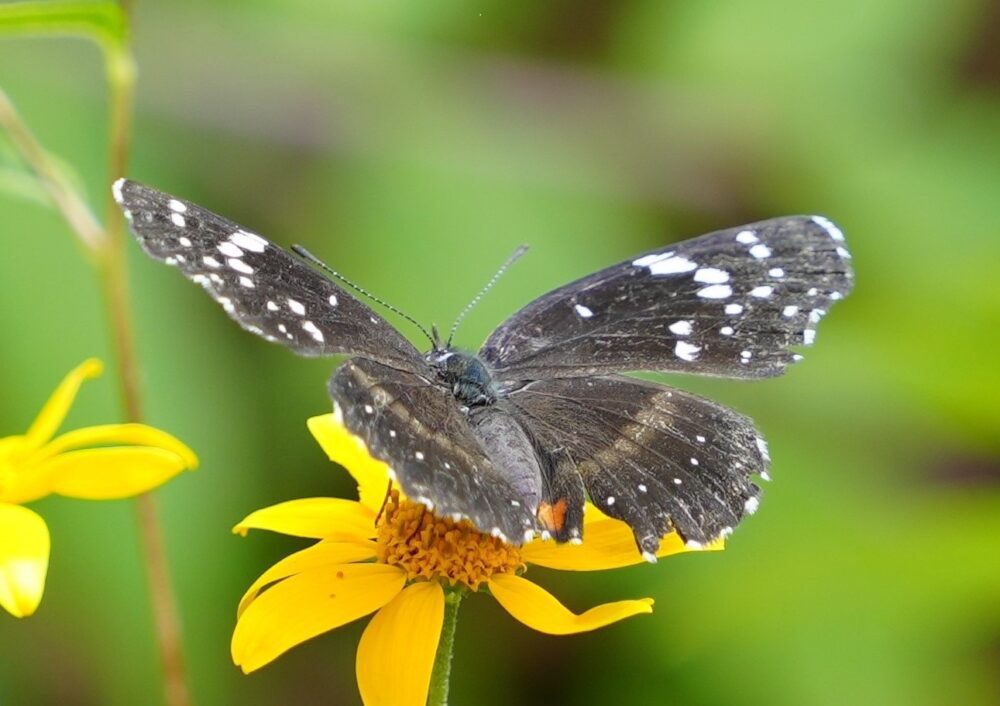
By the time we were returning down the same canyon we used in the morning, heading mostly south, the place was populated. Echo Azures (those were the only blues I saw the whole day), Orange Sulphur, Clouded Sulphur, Southern Dogface, plenty of Red-bordered Satyrs, some Canyonland Satyrs, a Duskywing (probably Funereal), an Orange Skipperling, and a fair number of Mylitta Crescents.
There were Bordered Patches as well. Some of them were normal enough with a narrow yellowish band over their hind wings, but some were rather odd, with only a ghost of a band – Borderless Bordered Patches. Naturally, I thought they were a species new to me. Why wouldn’t I? Naturally, I got disappointed, again. But that’s what makes butterfly hunting so much fun.
[Marta, these are the first butterfly reports ever from Holt Mountain. Thanks for hitting those high spots!]
A rare yellow form of Black Swallowtail: Is it Papilio polyxenes asterius form pseudoamericus? Or not…??? By Patricia Mann, Santa Fe, New Mexico, October 8, 2022. During the COVID shutdown, I immersed myself in organic gardening and growing my own food. I planted carrots, parsley, dill, tomatoes, basil, beets, lettuce, chard and a wide variety of culinary herbs. I took online classes given by the Xerces Society and New Mexico State University Extension (NMSU) learning about pollinators; our native bees, butterflies and moths and how to protect and provide habitats for them.
One day I found a beautiful caterpillar on my parsley. Realizing it was something special, I contacted Miranda Kersten at NMSU Extension asking her for an insect ID. It was a Black Swallowtail butterfly larva! Black Swallowtail females use plants from the carrot family (Apiaceae) as hosts; plants including dill, parsley, fennel and carrots (in the wild they will host on Queen Ann’s Lace and many other native parsleys).
I began reading about Black Swallowtails and their five larval instars. In the 5th instar, when the mature caterpillar is ready to go into chrysalis, it leaves the host plant and heads out somewhere into nature to pupate. In summer, when preferred varieties of nectar flower and host plants are plentiful, some chrysalids eclose in a few days, find a mate and begin the cycle again with the female depositing her eggs onto her preferred host plant. Other Black Swallowtail chrysalids may enter diapause, with development delayed for up to a year or longer, surviving freezing temperatures, snow and rain, to emerge in the following spring or summer when the weather is warm and both nectar flowers and host plants are available.
What happened to one of the caterpillars I found later that summer on my garden dill? After 11 months in a chrysalis, a beautiful female eclosed and was released on August 11, 2022. Something was different about this butterfly; unlike our normal Black Swallowtails, the abdomen was yellow, not black, and although the more extensive yellow coloration on the hindwings resembled a male, the abdomen was rounded and had no claspers. I identified it as a female (see photos below of yellow form Black Swallowtail and of a normal black-bodied female).
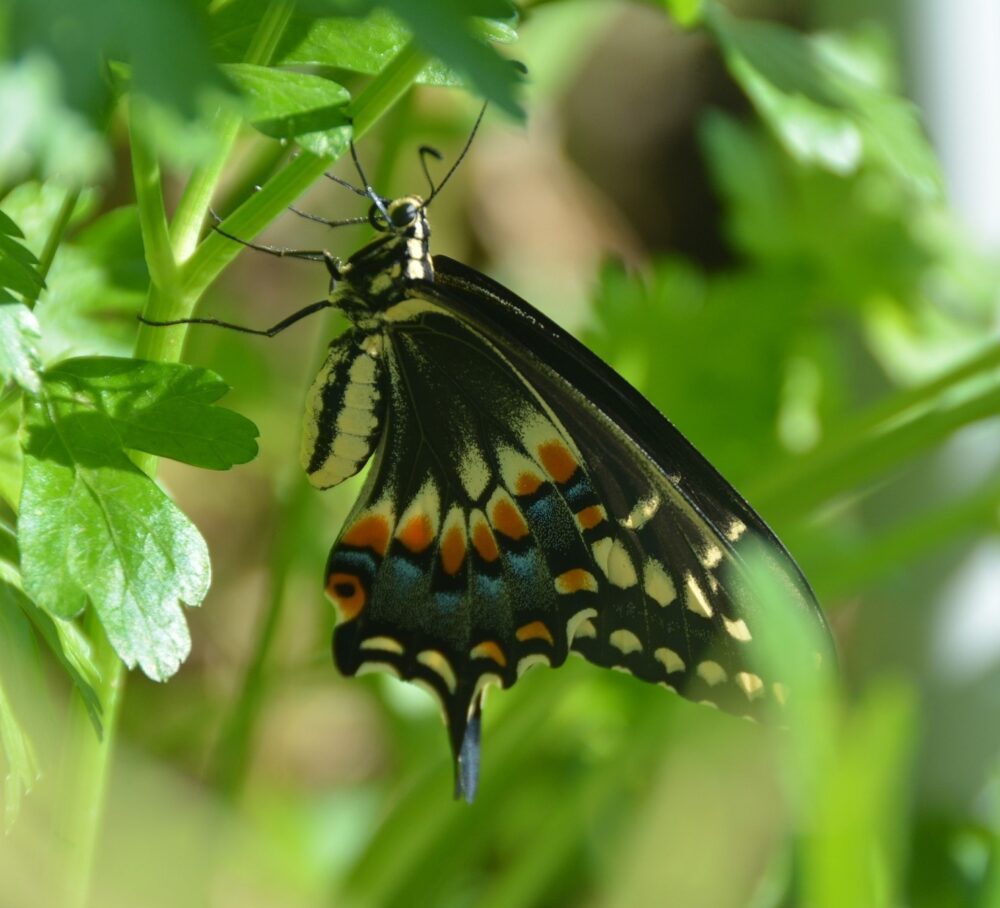
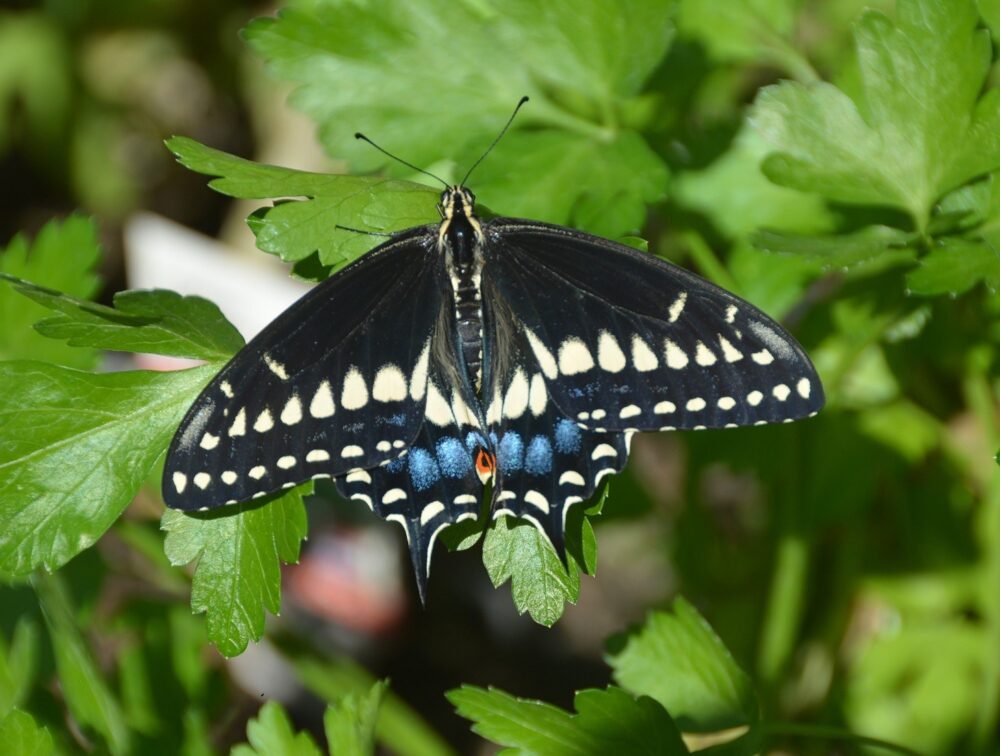
I began to research this variation in Black Swallowtails via a Facebook group, Simply Swallowtails. One Utah expert thought it resembled the rare yellow form “pseudoamericus”, but did not think the markings were exact. I then contacted Steve Cary, here in New Mexico, and he found citations of sightings of butterflies that resembled mine, identified as form pseudoamericus. I looked for other documented sightings of pseudoamericus and found several. Steve has added photos of my butterfly to the Pajarito Environmental Education Center (PEECnature.org) Butterflies of New Mexico website so others can see it too. My yellow form Black Swallowtail butterfly is also documented on Butterflies and Moths of North America (BAMONA).

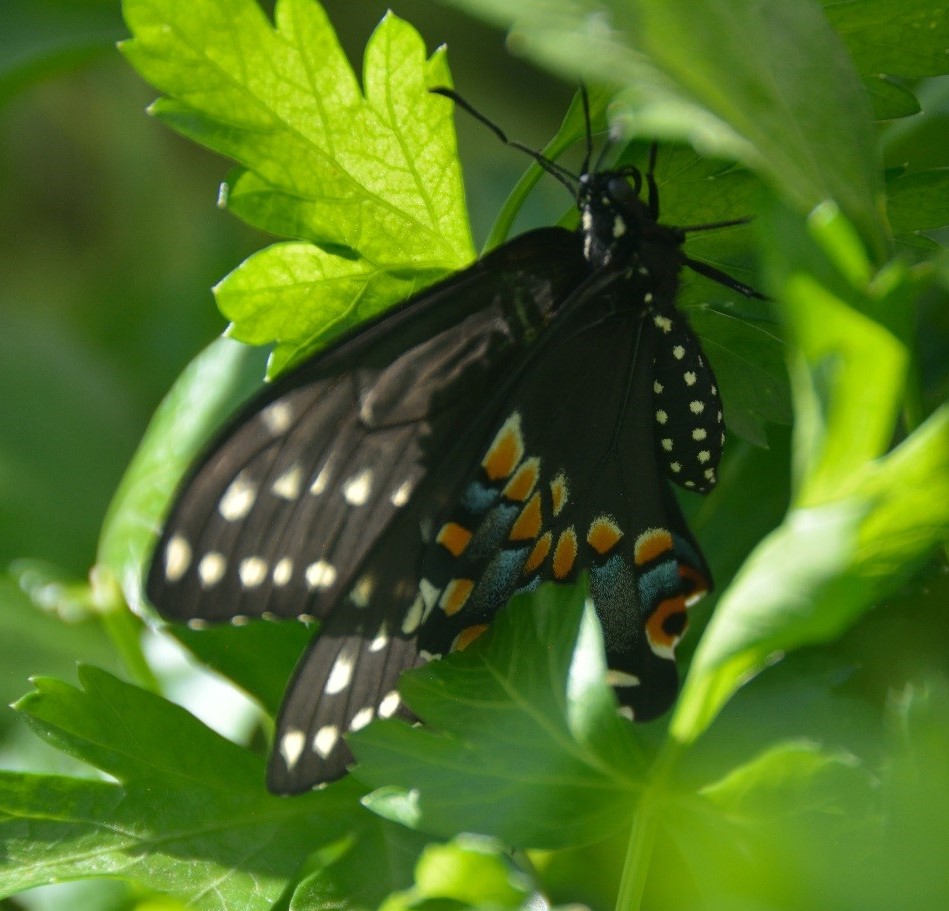
I would like to include a few other sightings of the yellow form of Black Swallowtail to give you, the reader, some more information about these rare butterflies. I found these references, including their photographs and discussions, useful in helping me to learn where these butterflies are generally found and what other butterfly experts or lepidopterists are saying about them. Some of the references do not identify the sighted butterfly specifically as pseudoamericus, but rather as a rare yellow form of Black Swallowtail. Others specifically identify the butterfly as form pseudoamericus.
Here are some of the other sightings found in the Southwest:
Documented sightings of butterflies thought to be pseudoamericus include one sighted in the Chisos Basin, Brewster County, Texas, USA, September 25, 2021, by Chuck Sexton of the US Fish and Wildlife Service (see Chuck’s photos and description from Southern Lepidopterists’ News, Vol. 43 No. 4 (2021), pg. 7). Chuck states, “The large amount of yellow on the HWs here is apparently just a rare color form of the “Eastern” Black Swallowtail, termed form “pseudoamericus” by Scott (1986, p. 172).” (1)
I sent photos of my yellow form of Black Swallowtail to Chuck Sexton in Texas. While he cannot confirm it as form pseudoamericus, he did reply and forwarded information from James Scott’s The Butterflies of North America, A Natural History and Field Guide (Scott, 1986, Stanford University Press). In reply to my query, Chuck wrote: “I read in Scott’s book (p. 172) that a yellow form (ssp. asterias form pseudoamericus) appears very rarely (IL, CO, NM, w. TX, s.e. AZ, but commoner in e. Mexico); its abdomen is suffused with yellow on each side between the yellow dots.” Chuck concluded: “Since your butterfly has less extensive yellow on the underside hindwing, I can’t be confident in calling it “pseudoamericus” but it certainly meets most other criteria, particularly the abdominal yellow pattern.”
A sighting of a Black Swallowtail butterfly identified as pseudoamericus occurred in Tulsa County, Oklahoma, USA on June 20, 2019 and is documented on BAMONA. The BAMONA Coordinator notes: “This is an uncommon yellow form of polyxenes, asterius fm-pseudoamericus, sometimes seen in west TX, NM, Mexico, or other areas related to, but distinct from, ssp. coloro which is resident further west in AZ, CA, NV.” (2)
Another sighting by J.B. Sherrick in Chambers County, Texas, USA, on August 19, 2010 was a female identified as a yellow-form of Black Swallowtail. It was identified by David J. Ferguson on Bugguide.net. David writes: “It’s a yellow form Black Swallowtail. They pop up now and then, most often in the Southwest, and are much more common in Mexico and the Deserts further south and west where other subspecies occur.” David J. Ferguson, 25 September, 2010. (3)
Another important sighting of a male yellow form Papilio polyxenes was on June 4, 2006 by David J. Ferguson, Tierra Grande, Valencia County, New Mexico, USA. David documented this sighting on Bugguide.net and included photos and some discussion. (4)
In addition, pseudoamericus is documented in another post by David J. Ferguson on Bugguide.net. David contributed this post about Subspecies Papilio polyxenes asterius fm pseudoamericus – Black Swallowtail. This post includes several photos submitted by David of his 2006 Valencia County, New Mexico, sighting as well as others who had documented sightings of these rare yellow forms of Black Swallowtail including Chuck Sexton’s 2021 Chisos Basin, Texas sighting and J.B. Sherrick’s 2019 sighting in Chambers County, Texas I mentioned above. (5)
David writes: “There is no taxonomic distinction of this form of the Black Swallowtail, but they have been put under their own heading so that it is easier to find them. This is a rare color form in this subspecies, but it can turn up most anywhere. It does seem to be marginally more common in the Southwest (Arizona, New Mexico, Texas, northern Mexico), perhaps because these places are geographically closer to subspecies coloro and other Mexican subspecies that commonly exhibit the yellow color form.”
In conclusion, it is a joy to be able to share with you my August 11, 2022, sighting in Santa Fe County, New Mexico, of this yellow form of Black Swallowtail. I am sure there will be many different opinions and ideas about the correct identification for this beautiful butterfly. Perhaps you know of other documented sightings of the yellow form of Papilio polyxenes asterius which resemble, or may truly be, form pseudoamericus.
So, dear readers and lepidopterists, I put this query out to you: What identification would you give to this apparently rare yellow form of Black Swallowtail?
- Sighting of pseudoamericus, September 25, 2021 by Chuck Sexton, Chisos Basin, Texas. Sexton, C. (2021). Southern Lepidopterists’ News, Volume 43 (4). https://www.researchgate.net/figure/The-rare-pseudoam-ericus-yellow-form-of-Black-Swallowtail-nectaring-on-firecrackerbush_fig7_361177021. Additional information and photos and an interesting discussion of this sighting are also documented on Inaturalist.org by Chuck Sexton, US Fish and Wildlife Service under Chuck’s online ID “gcwarbler”, and on Bugguide.net.
- Sighting June 20, 2019, Region: United States, Oklahoma, Tulsa County, Butterflies and Moths of North America (BAMONA).
- Sighting August 19, 2010 by J.B. Sherrick, Chambers Co., Texas: https://bugguide.net/node/view/447495.
- Sighting June 4, 2006 by David Ferguson, Tierra Grande, Valencia Co., New Mexico: https://bugguide.net/node/view/156368.
- David J. Ferguson, Subspecies Papilio polyxenes asterius-fm-pseudoamericus – Black Swallowtail: https://bugguide.net/node/view/462276
[Patty, kudos for bringing this interesting swallowtail situation to the attention of our readers. I wonder if there are more pseudoamericus individuals out there to be seen, if only we will look for them.]
What Drought? by Elaine Halbedel. After completing 32 surveys over the summer for the New Mexico Butterfly Monitoring Network, I can say with authority that it’s been a PHENOMENAL year for butterfly numbers in some of my four survey areas. I am now locked out of two of them: Railroad Canyon (closed for the rest of the year because of the Black Fire) and the Gila Bird Area (after the millennial August Gila River flood the trail has collapsed and is so choked with downed trees that it is impossible to traverse). However, Little Cherry Creek and especially Meadow Creek have really made up for those losses in terms of species and numbers. On August 30th in Meadow Creek I had 221 Echo Azures, 39 Nokomis Frits (of which 1 pair was in copulo and 7 were females), and 55 American Ladies, all in the space of a little less than 2 miles of trail.

Here’s what I wrote for the survey comments for that day: “With water levels receding, I was finally able to access the survey route following the torrential rains which produced considerable nearby flooding. The canyon was phenomenally productive. The flower display was dazzling, with acres of Rothrock’s Basketflower (Plectocephalus rothrockii) and numerous composites. Butterfly numbers were staggering, with puddle parties consisting of 30-50 members.
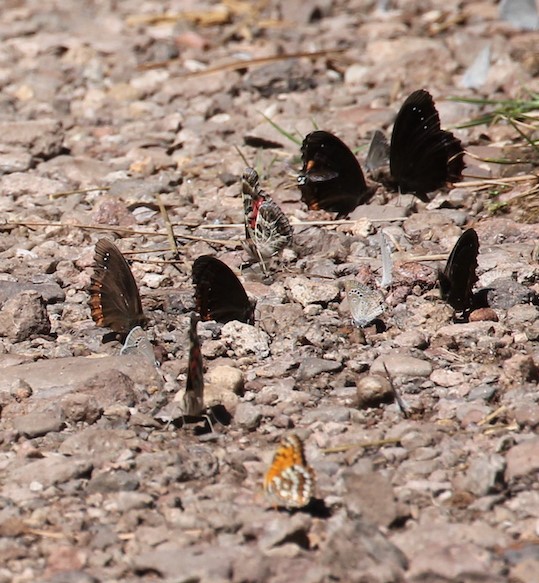
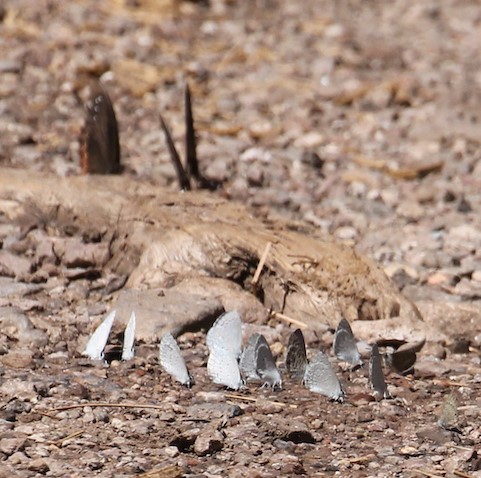
I also observed more Nokomis Fritillaries than I have ever seen before anywhere, including one undamaged male which was dropped dead at my feet from an overhead tree limb by a Steller’s Jay. Could the species be poisonous or bad tasting? I also found more female Nokomis Frits than ever before: 7. This gave a female to male percentage of 18%. Red-bordered Satyrs were numerous and early. There was a phenomenal flight of American Ladies, with all in pristine condition. The large number of Echo Azures is likely an undercount since they made up the largest constituent of the puddle parties and it was difficult to keep track of individuals. I resorted to photographing the assemblages and counting from photos.”
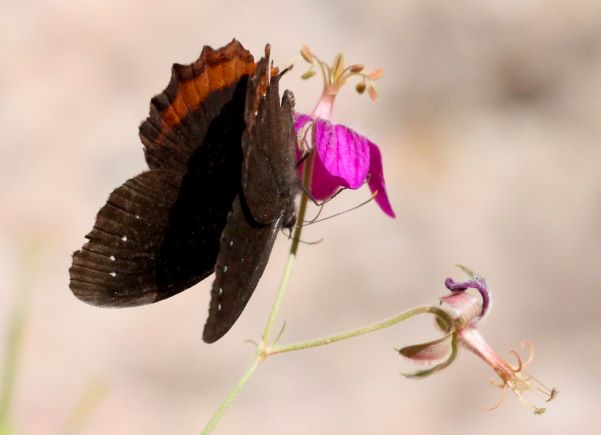
This has been one of the best flights of Red-bordered Satyrs EVER. All canyons (and my yard) are full of them. They were easily the most abundant species in late summer/early fall. Curiously, there were almost no Painted Ladies this year, with the bulk of Vanessa being virginiensis. Last year’s Apache Skipper invasion has not rematerialized yet, but it has been so rainy that I haven’t caught a sunny window yet to go look for them. There has been so much rain that the flooding in local canyons has made access very difficult. I’ve been wading thigh-deep in some of these narrow canyons to do the surveying and the access roads are damaged. There is no road in the narrows of Little Cherry Creek any more, just knee-high steps of rocky strata.
[Thanks for that story Elaine. It’s a good reminder to keep some hip-waders in my truck, even during a drought!]
Jerry & Donna’s Ark, by Steve Cary. This past summer of 2022 had a weird aura about it in northern New Mexico, don’t you think? The nasty drought stretching from spring into early summer rendered the outdoors eerily quiet. The Hermits Peak/Calf Creek wildfire complex, raging from Las Vegas to Mora, leant an atmosphere of smoky dread to the entire region. The early onset of monsoons in mid-June was joyously welcomed, yet we were suspicious; rain in mid-June did not feel right somehow. Summer rains persisted through July, August and into September, greening things up rather well, even by historical standards. It verged on the old “normal” except for the paucity of insects. To go into lush, verdant, flowery mountain meadows and see one fly, hear one bee buzzing, note a solitary moth and two butterflies, raised uncomfortable questions.
All that occurred in the context of large scale, long-term climate shifts, inexorably changing our ecosystems . . . and what are we to do about it? It remains a psychic miasma for me, perhaps for you, too. Coloring those personal experiences were two literary highlights that were infused with climate change, courtesy of William DeBuys and Andrea Wulf.
Bill DeBuys is a phenomenal northern New Mexico writer of longstanding. I read one or two of his early works, many of which delve into conservation issues that resonate with me. This year’s The Trail to Kanjiroba really struck a chord which gained clarity when I heard him speak about this book at Santa Fe’s first Literary Festival, back in May (thanks, Amy, for getting me there!)
Andrea Wulf is this year’s Miller Scholar at the Santa Fe Institute. Her 2015 biography of Alexander von Humboldt (The Invention of Nature) was one of my favorite books of the past decade. Because I am a geographer by general outlook, explorer Humboldt’s realizations 200 years ago that (1) everything in Nature is connected, even Man, and (2) that Man is changing Nature, make him a hero to me. Besides that, I went to a Milwaukee high school right next to Humboldt Park. So I could not miss Wulf’s public lecture on Humboldt on August 2 at the Lensic Theater in downtown Santa Fe.
* * *
Jerry & Donna invited John, Jane, Marcy and I to spend a couple days at their cabin north of Angel Fire. They have owned and stewarded the cabin for more than 40 years. Raised in Colorado, Jerry uses the cabin as a regular refuge and sanctuary for his family and friends, for peace and quiet, family weddings, and the like. Around the cabin they own 40 acres, while friend Dan owns ~165 adjacent acres; together they manage the ~200 acres as best they can for the benefit of nature, wildlife, and serenity. This past summer, while the Calf Creek and Hermit’s Peak fires were clawing their way up the east side of the Sangre de Cristo Mountains, elk moved north to keep ahead of the fire. Hundreds found temporary refuge in the meadows near Jerry’s cabin.
A wise, thoughtful and handy fellow, Jerry does regular maintenance and makes periodic cabin upgrades, adding to coziness while retaining the rustic feel. The cabin is a bit of a drive from Santa Fe, so he typically has a project in mind each time he goes there. Thinning trees has been popular in recent years. I have accompanied him a few times as guest and helper, and the sound of chainsaws was not uncommon. He heats the cabin with wood, and Marcy and I have a wood stove at our home, so it all gets put to use.
This particular visit on September 10 was not about getting projects done, no tree felling was on the menu. Nor was it a butterfly expedition because at 8500 feet elevation it was too late in the season (but stay tuned). This was just to spend time relaxing and conversing with dear friends in a precious location.
Bill DeBuys had concluded his recent book with five terse to-dos; one of the easiest (for me) was to “build an ark.” That resonated with me. I want to save native species, so we are managing our urban Santa Fe lot with that in mind. True, it’s a small ark, but I know other people who take a similar approach; a million small arks mean something. And some have larger pieces of land . . .

Sitting on the cabin deck I always see weeds, non-native intruders mostly brought in on legs of cattle and elk. On that first afternoon I jumped right on them, filling a trash bag with houndstongue (Cynoglossum officinale) and moth mullein (Verbascum blattaria). Last year it had been beggar’s lice (Hackelia virginiana), which seemed blessedly scarce this year – can we take credit for that? Small steps, I keep telling myself, and Jerry, too. Rome was not weeded in a day. I plug away at this every time I visit, but of course the elk wander through these weeds elsewhere and unintentionally re-seed the meadow.
The next morning was sunny, chilly and lovely as Jerry walked us unhurriedly around the property. It was John and Jane’s first visit, all new to them. We stepped slowly through grassy meadows edged with Engelmann spruce, blue spruce, ponderosa pine and gooseberry shrubs. The area had been logged in the 1920s and weathered, hand-sawed stumps could still be spotted here and there, but you had to really search for them among the large, mature trees of the present forest. Time may matter to us humans, but not so much to the forest. We passed an occasional standing dead spruce. Here and there another had blown over. Elk trails were not hard to see or follow; most were aligned east and west, evidently used to get from higher woodlands to lower meadows.
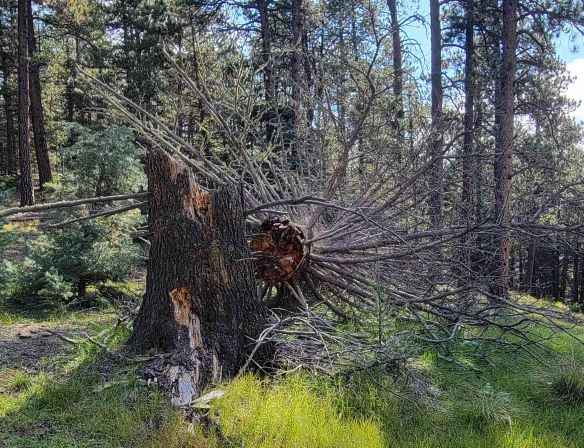
Old fires are evident here: live trees that had been scarred, but survived; burned wood of uncertain ages on the ground. This year’s Calf Creek/Hermit’s Peak wildfire complex came within about 10 miles of this place. Jerry and Dan kept a careful eye on things as it blew toward them, but you can only do what can be done. Eventually they called it good and then stayed out of the way of fire fighters. Fire is the future here, as it is in all our forests – past, present and future. Can we adapt?
The rising sun warmed and dried the dewy meadow as we walked gently downhill to the next small valley. We saw our first butterfly – a worn female Great Spangled Fritillary. Most butterflies at this latitude and altitude had completed their life cycles for the season. A few stragglers remained, still putting eggs out there or hoping for a final mating, but time was running out.
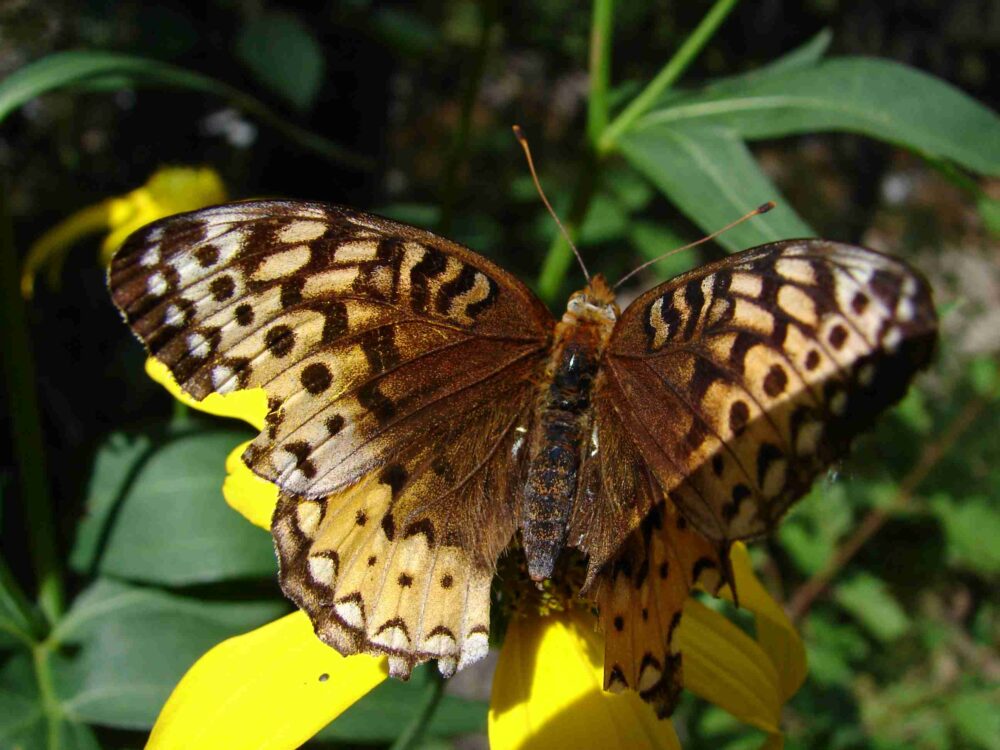
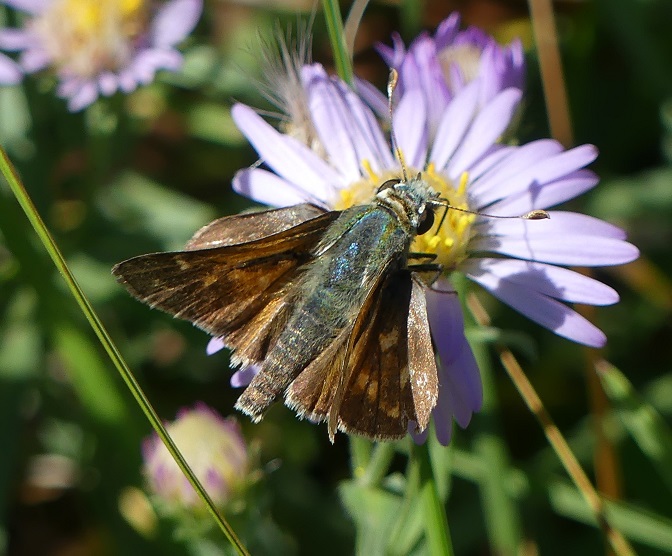
Continuing our amble, we walked out of the fritillary meadow and pointed down-valley, out of the trees. We startled a purplish copper, then an orange sulphur, western branded skipper and checkered white all made themselves evident. A Green Comma fluttered at the sunny base of a conifer. There was a cavity in the tree right at ground level, maybe a burn scar, but it seemed a possibly attractive place for hibernating butterflies to hunker down for winter.
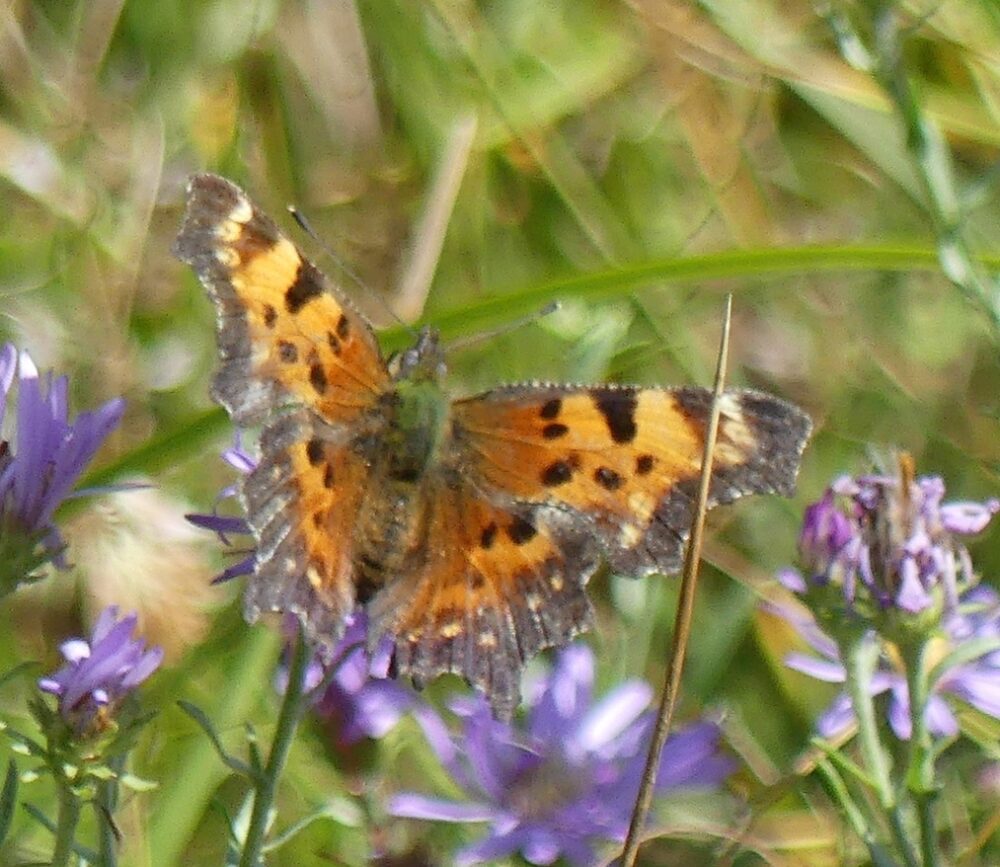
We traced an old, overgrown two-track road which skirted up and over a low ridge to a broad meadow with expansive views. Jerry explained this had been the site of a housing camp for a nearby lumber mill c. 1920. Jerry commented, “It is interesting to think about the camp placement. The valley floor is lower and colder – best to be encamped a little higher up the landscape.” It was easy to gaze up and away from the site itself and imagine living in that camp a century ago . . . not that different today, except perhaps for technology.
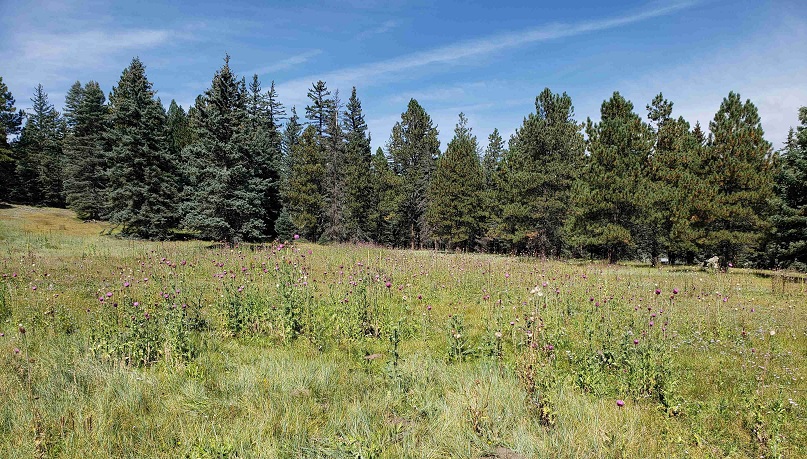
The former housing encampment site was now a weedy, open area packed with musk thistle (Carduus nutans), houndstongue, and beggar’s lice – “sockstickers” as Marcy calls them. As we approached, it was hard not to notice the family of mountain bluebirds – parents noisily training up the fluffy, reluctant youngsters to forage for insects and feed themselves. Teenagers!
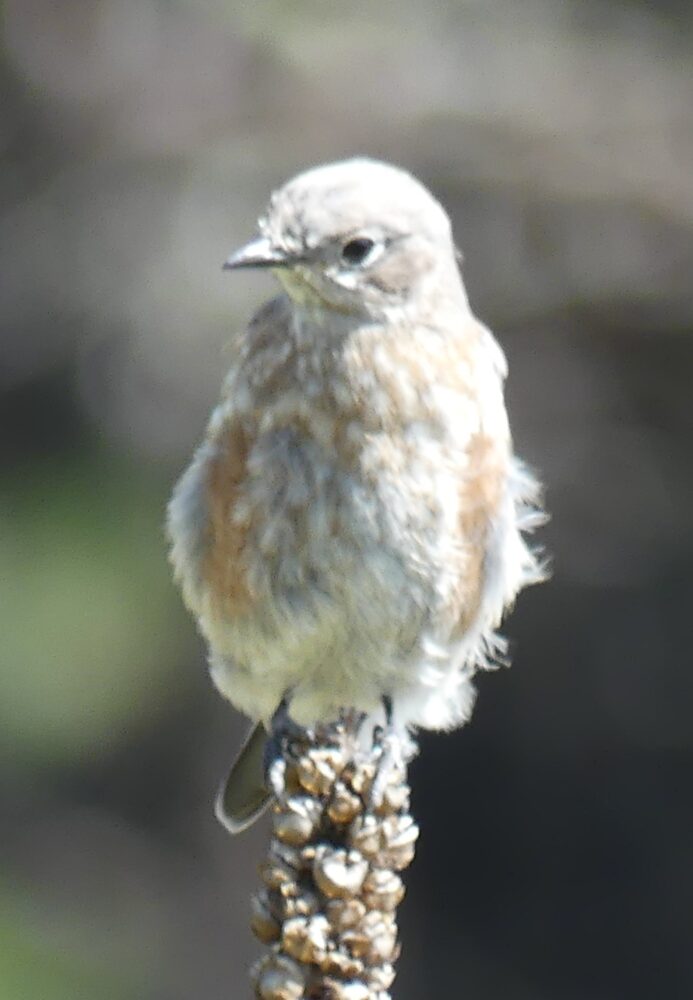
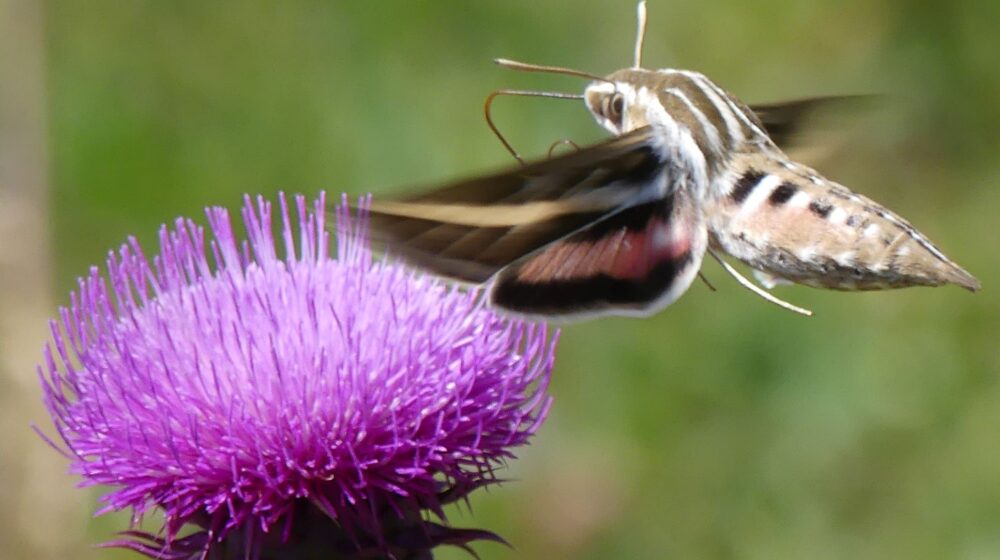
By now it was 10:30, cloudless and warm. It was hard for a butterflyer like me to stroll inattentively past a large stand of blooming thistles. Don’t get me wrong, I’m not pro musk thistle, but as long as they are there, it is nice that they offer a service. First, there were the white-lined sphinx moths (Hyles lineata); their superabundance this recent summer in no way detracted from their beauty or the wonder of their hummingbird imitations.
Then I saw a monarch. It seemed very pristine: fresh and undamaged, very unlike the other tattered butterflies we had seen. It moved from one flower to another, basking as it went. Then there was a second monarch – same story – perfect in every scale and wing margin. It was so focused on nectar that it let me pluck it from the flower. It dawned on me that at this date in September, at 8500’ in Colfax County, without any milkweeds in the vicinity, perfect monarchs at morning nectar were probably southbound migrants. We saw three in total, in about five minutes. We had seen no milkweeds, so these were not “breeders.”
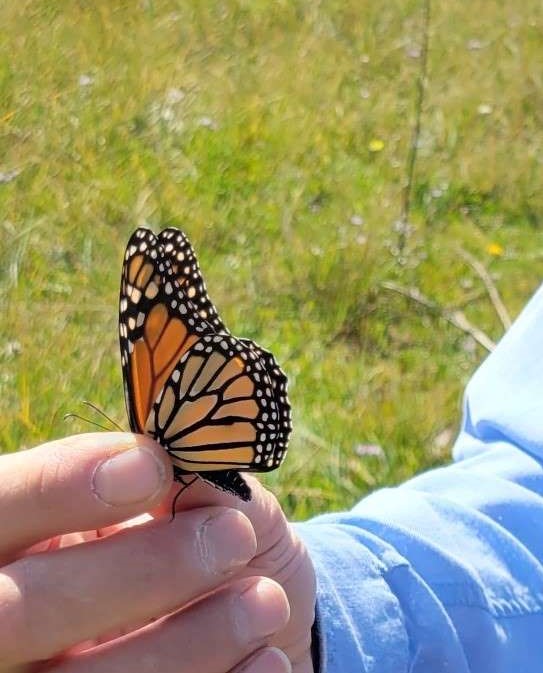
Walking distractedly back to the cabin, I realized there was a two-step method to test if these Monarchs were migrants. First, migrants should not be there nectaring at mid-day, when migrants are busy migrating. I went back at 1:00 PM just to check, and there were no Monarchs. The morning’s thistle visitors had apparently refueled successfully and gone on their way.
After lunch, Jerry and I resumed work on the weeds, filling a second trash bag with Verbascum, Siphonoglossa and Hackelia. This is very satisfying work – cleansing the big meadow of these plants, at least visually, for now; no doubt there are more to come. The houndstongue (Jerry astutely observed that “catstongue” would be more apt) from last year stood out in the meadow, extending above the grasses and being gray/brown – last year’s dead with all (most?) of the sticky seeds still attached to the plant. With a nylon sleeve and a leather-gloved hand, I grasped a cluster of stems at ground level, twisted toward the soil surface and they snapped; pull up and deposit in trash bag. Move over two feet and repeat.
Beggar’s lice (can I even say that? It seems unkind.) is similar to houndstongue. Dead plants from last year are gray, with barbed sticky seeds still attached, but smaller and harder to see. Grasp at the base, twist to snap off, then place in trash bag. I emphasize the need to wear smooth or tight-weave fabric on which these various cloth-grabbing seeds will not get purchase. Leather gloves and a nylon shirt or jacket worked well. I do not want to be a seed vector for these plants!
For the mullein, bend knees, lean over, tightly grasp the flower stalk at the base with both hands, then straighten legs while keeping back straight (very important). If the soil has sufficient moisture the plant will pull right out, root and all (very satisfying). For those with tender knees or back (most of us?) Jerry had a nice innovation – whack the base of the plant with a hatchet, then pull up. Deposit in trash bag.
* * *
Step two of “are the Monarchs migrants?” test: by late afternoon, as the sun declines and the day cools, most migrating Monarchs come back to earth to find nectar and an overnight roost. Another visit to the thistle patch at 4:15 PM produced one fresh, pristine Monarch getting nectar; to me that was further evidence that today’s Monarchs were migrants. I have no idea where they came from, probably high plains or montane valleys north of here. I have no idea where they might roost in the area at night, but there are plenty of trees on this east-facing slope that offer suitable cover plus access to nectar and morning sun.
Their numbers were small, but if I had brought tags, we could have tagged at least four Monarchs that day. And if weather held and we stayed for several days, we might have been able to tag a couple dozen. For me it was rare to see actual migrating Monarchs so accessible. It may never happen there again like that, but it was happening that day. Perhaps next year I will get some tags and make another visit.
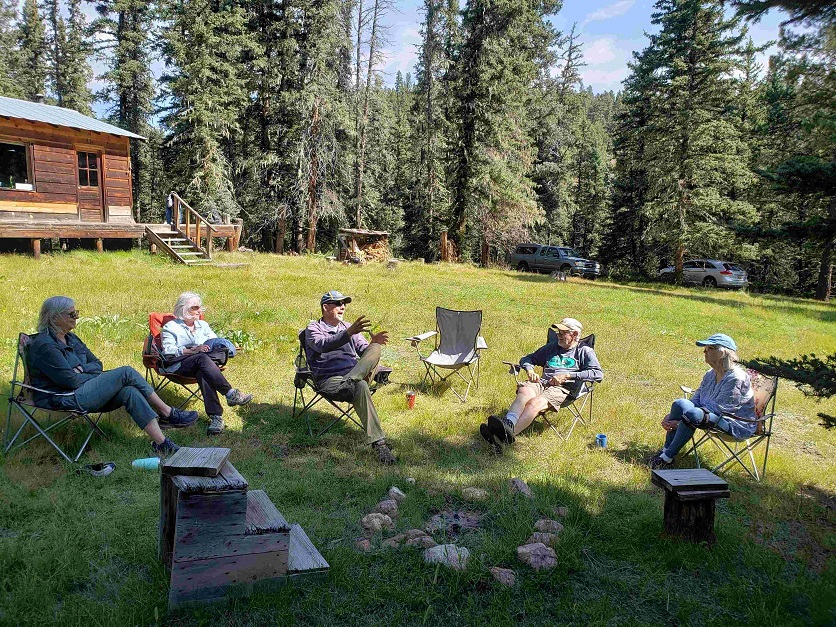
We carried out the day’s rituals: afternoon nap, happy hour, dinner prep, dinner, dishes, a walk and continual search in vain for the elk we knew were all around. Then we all retired, us to our trailer parked in the low meadow along a small stream, below the cabin. A full moon rose and all was still but for the barely audible creek burbling 50 feet away. Dawn the next day broke at 37 deg F; those Monarchs don’t have a lot of time to get out of the Rockies. Soon it will be snowing in the high country – or so we dearly hope.
* * *
In the context of my summer reading (DeBuys), I like to think of the land preserved by Jerry and Dan as a large ark to which I can contribute some expertise and effort, while I do my best to absorb beauty and community along the way. Per Ms. Wulf, I try do it with love for the land, the plants and animals, all you other humans, and myself.
Finally . . . at about 3:30 PM on October 15, I was nearing the end of a bicycle ride. The paved shoulder was aligned toward the southwest and (phew!) downhill. Juniper-studded bluffs moderated the westerly breeze, so I was enjoying the illusion of going fast under my own power. To my left, motorized traffic zoomed along at a safe distance. When I glanced to my right, I saw a fellow traveler – a monarch butterfly was flying next to me at head height, also capitalizing on the windbreak offered by the bluffs. We flew in tandem for perhaps 10 seconds. I’ll never forget that.
May many migrating Painted Ladies and Monarchs decorate your rabbitbrushes this autumn.

Re: Marta’s peak-bagging adventure. Her Dymasia dymas is actually Microtia (another genus change per Zhang and colleagues) chara. Maybe that’s another one to add to her list.
And Elaine’s P. arachne looks more like a C. acastus to me, but I can’t really tell for sure. I bet she knows the difference!
Steve – for years I kept the Garlic Mustard out of our local woods in Eureka, IL, using the pull and bag technique. I don’t know what it’s like there since we moved; sometimes it seems like a losing battle! It’s a battle worth fighting.
I think you b right, Mike. Elaine’s Arachne is a Sagebrush CS.
Jim B
Mike, thanks for the kind words! I agree that the px resembles acastus but that species usually flies only in the spring here and I have never seen one past late May at any location. Perhaps it could be a 2nd generation, though, in this very strange year. I never actually noted the relevant details of the butterfly at the time I took the shot because I was too busy counting everybody else for the survey data sheet and it flew just as I took note of it. Both of the ‘puddle party’ shots here were cropped by Steve from a single photograph, which shows that I was a considerable distance away. Consequently I cataloged it as ‘checkerspot species’ for the survey, which tells you how uncertain I was.
Thanks for the correct checkerspot ID! Elaine had not mentioned it, but felt I needed to say something. Frankly, I struggle to distinguish Sagebrush CS from similar species; I leaned on the timing, which as Elaine says was good for Arachne but off for Sagebrush. Thinking about it, however, I have seen Sagebrush fly in Taos County in mid-summer one other time, also following heavy rains. Which reminds me that Dick Holland caught a couple of New Mexico (Sandia) Hairstreaks in July, triggered he thought by unusual heavy June rains. So I gather that some spring flyers can be provoked out of pupal diapause way ahead of schedule by unusual weather events. of which there are probably more to come . . .
Elaine – that makes perfect sense. The acastus 2nd brood is apparently a rarity there, but I’m guessing that’s what you got. I’m jealous of the nokomis – I only saw one in my years in NM – a male at Bluewater Lake State Park. And the Red-bordered Satyr is one of my favorites: I’ll never forget my first experience with it down in the Peloncillos. Nice photos!
Re: Patricia Mann’s article on the yellow form of the Eastern Black Swallowtail: Her female example from Santa Fe has all of the characteristics of the yellow form named pseudoamericus except it lacks the expanded yellow bands on the wings both dorsally and ventrally. Those via the links are more typical examples of the yellow polyxenes form. The bands on the upperside tend to vary from nearly typical polyxenes (short) to the entire expand to the base of the hindwings yellow like the Anise or Bruce’s Swallowtail. I have one as such from the Front Range west of Denver but all of these are of very low frequency of occurrence. This had turned up somewhat frequently in SE Colorado the past three years and photos of a female this year looks very much like Patricia’s example…very interesting butterflies…and probably have their origin in hybridization with the Old World Swallowtail, Papilio machaon (bairdii (black form) and brucei (yellow form) in our region.
Mike, thanks for your constructive comments and for sharing your vast experience with regional butterflies. Your thoughts on hybridization with machaon are interesting; would this be ancient or modern hybridization, in your opinion? Here’s another question for you: are all pseudoamericus essentially the same phenotypically (setting aside gender) or do they vary in terms of which machaon characters they display?